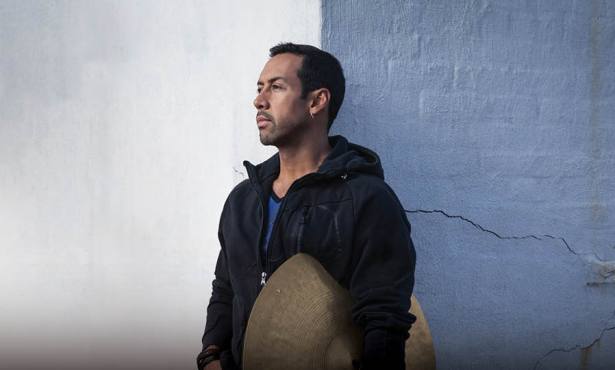Musicwood
Director Maxine Trump and Greenpeace’s Rolf Skar

In this thought-provoking examination of natural resource extraction and how it intersects with the music business, the world’s premiere guitarmakers team up with Greenpeace to convince a Native American-run corporation to stop clear-cutting spruce trees in Alaskan rainforests. Along the way, we hear from Steve Earle, Yo la Tengo, The Antlers, and other acoustic-powered heavyweights. Below, we chat with director Maxine Trump and Greenpeace USA Forest Campaign Director Rolf Skar about the film.
This film was a long time in the making. What were some of the bigger struggles you guys ran into while getting this thing finished?
Maxine Trump: Probably the biggest struggle with making Musicwood was just how remote the Tongass rainforest is, and how rare the huge old-growth trees are. Early on in the filmmaking process, we knew the film would be working if it felt like we were bringing this beautiful rainforest right into your living room. Everyone was talking about how gorgeous the forest was, and how it was a real “crown jewel” among forests, but it was so incredibly far away.
And once we even got to the forest, it was so difficult to find the giant old-growth trees that the Music Wood Coalition is talking about saving. We knew this might be the case — this is part of why we were making the film after all — but weren’t prepared as to just how hard it would be. We had to fly on a tiny seaplane, take a small fishing boat up a remote, secluded river, and then hike deep into the forest, far from any civilization, to be able to find the big trees to film.
There was another obstacle to overcome, that we were white US and UK filmmakers who were telling a story that had a huge Native American component to it. We wanted to make sure we were telling a truthful and honest story that respected the history of a tribe we initially knew little about. So we had to make sure we had a Native consultant and screened a rough cut to a Native American tribe that was not involved in the issues so we could make sure the Native aspects of the film were being fairly represented.
Other than that, and beyond the classic independent filmmaker struggles of finding money and getting people (and musicians) to agree to participate in the film, it was also a real struggle in the editing process to figure out just how to tell this incredibly complex story. It’s a political story, a cultural story, an environmental story, and a story about music, with an absolutely Byzantine maze of twists and turns and complexities. Figuring out how to make that all clear and engaging for an audience was extremely challenging, but we’re really pleased with the way the film came out, and audiences have been telling us that they’re really enjoying the way the film takes them to places they never thought they’d go.
In your eyes, where do you want the film to end up? Festivals? Classrooms? Board meetings?
MT: It may sound cliché, but we just want as many people to see it as possible; whether it’s on their computer, at a museum, in a classroom, or we hope in a local cinema. The forest really does come alive on a big screen, and it was so important to us that we captured the incredible beauty of this primeval rainforest. We always hoped that Musicwood would be useful as far as explaining lots of factual information to people: facts about logging, about how guitars are made, about this amazing forest right here in the US, about Native Americans in Alaska, and cultures that the average American might have no idea even existed. But more than that, we were determined to make a factual film that was entertaining, surprising, and moving.
What do you hope folks will take away from the film?
MT: It’s really interesting that so many people we talked to, including some musicians, didn’t actually ever think about the fact that the guitar comes from a tree. So much of what we use today comes from trees. Diapers, fast food packaging, tissues, musical instruments, and of course all kinds of construction materials and furniture. We hope that people come away from the film with a sense that this wood is not an infinite resource, that when these giant centuries-old trees are gone, they are gone forever. And that we are currently in a time where people, money, and wood are intersecting in a very fundamental way. People should have a real take away that by buying sustainable woods, just like with other sustainable methods like fishing, they can make a difference to the future of these forests.
Rolf Skar: Maxine’s right. Recognizing the connection between what we buy and the planet’s resources is the first step in accepting personal responsibility for our actions. Through the movie, I also hope people learn a bit about Greenpeace. We’re not the caricatures people often imagine when the name “Greenpeace” is mentioned. People associate us with civil disobedience and conflict or with ships and whales; while we are proud of our tradition of peaceful protest, we also do a lot of smart, collaborative work to develop real-world solutions to environmental problems. I think the Music Wood campaign, though not finished, is a good example of that.
What comes next? Where is the campaign today?
RS: For Greenpeace, the Music Wood Campaign is currently on hold as we concentrate on other ways to protect rainforests in Alaska. In particular we’re focusing on the portions of the Tongass controlled by the federal government. The US government continues to use tax-payers’ money to subsidize destructive logging and road-building projects in the Tongass, and Greenpeace is working to stop that. We’re hoping the Musicwood documentary will spark new interest in this campaign, and help make sure these ancient trees are protected.
MT: Spoiler alert for anyone reading this before they see the film: Sealaska unfortunately are near the end of their supply of wood due to over-harvesting so the campaign is at a bit of a standstill. They are waiting to figure out their land bill (in which they hope to acquire a new allocation of federally owned land), which is caught up in the quagmire of Congressional politics. Until that is resolved they’ve said they can’t move any further forwards with the campaign. Their land bill is incredibly complex and has received some pretty strong opposition from various environmental and Tongass-based groups. We have a big moment in the Musicwood documentary all about this, and unfortunately it’s still an issue today. So the campaign is at a standstill unfortunately.
Has any progress been made above and beyond what we learn at the end of the film?
MT: Because Sealaska are now pre-occupied with their land bill, there has been very little conversation between all parties lately. With Musicwood beginning to play at festivals and get into the popular consciousness, the conversation has picked up again between the parties, and we hope in the end to reach a positive result for everyone. Martin Guitars have produced FSC guitars for some time now, and they’re making some real headway into making sure they are sourcing good wood. Getting enough FSC wood to do this, and enough FSC products in the market place, was slow when we first started making the film. Now FSC is an option in so many choices you make daily, from your Kleenex tissue box to toilet paper, notebooks and of course lumber at Home Depot. That’s been pretty amazing to see.
There’s a wonderful tribe called the Menominee, in Wisconsin, who are FSC-certified loggers. They felt that the FSC practices mirrored what their spiritual values had always told them as far as revering their land and their forest. So it can be done.
As Bob Taylor of Taylor Guitars once said, for all forest owners, FSC may be a decision that they have to make in the future. It won’t be an option because people will always have a need for wood products, and to keep up with that demand without running out of supply will require forest managers to manage their forests sustainably.
More and more forest owners in the US are making these choices. We remain hopeful that Sealaska will also see this as less of a risky move and more of a smart business decision; that sustainable forestry can be economically viable for them in the future, or perhaps at least their native shareholders will feel it’s essential for them go in that direction and encourage the Sealaska board to make that decision. We’re still hopeful!
RS: Greenpeace is ready to re-engage with Sealaska to pursue Forest Stewardship Council (FSC) certification for their logging operations when they are ready. Despite our differences, I think we also have common ground. From the Greenpeace perspective, the wood being logged by Sealaska is being shipped all over the world.
What prompted you guys to link up with the guitar world, as compared to other companies on the receiving end of this product?
RS: The Tongass rainforest needed a voice and champions to speak up on its behalf. We knew that the guitar makers had a vested interest in the fate of the forest, which would encourage them to join our cause. The shrinking availability of older Sitka spruce means a real problem for them in the long run. The high-grade Sitka spruce used for guitar tops, if managed sustainably, can represent a long term source of income for Sealaska. So we hoped the company could be persuaded to listen the guitar makers.
Many of the other end uses of Sealaska’s wood — like lumber sunk into the foundations of homes in Japan, for example — don’t afford as many opportunities to capture people’s imaginations and harness the power of the marketplace for change.
Is it your belief that most companies/company owners simply don’t think about these issues when sourcing materials?
RS: We are witnessing a sea change in the way major corporations deal with sustainability in their supply chains. In the past, most companies just cared about price, availability, and a limited number of quality specifications. It is now becoming normal for companies to pay attention to the impact of their supply chains on people and the planet. Customers, staff, and investors increasingly expect this. A key challenge is showing real environmental leadership instead of “greenwash” — something consumers are very skeptical of. Greenpeace is working hard to encourage companies to set the bar higher and live up to it, whether it’s guitar wood from Alaska, or KFC’s fast food packaging, made from Indonesian rainforests. Some companies around the world are starting to see that being responsible, and setting high standards for wood products in their supply chains is actually good for business.
Musicwood screens on Fri., Jan. 25, 4 p.m., at the Metro 4 and Sun., Jan. 27, 1 p.m., at the Museum of Art. See musicwoodthefilm.com.



